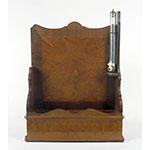This apparatus provides a visual display of the path of a liquid projected from a nozzle at different angles.
A profiled rectangular wooden vessel holds an upright panel carrying a glass tube at one end. The tube is fitted with a faucet whose angle is adjustable from 0° to 90°. When the tube is filled with mercury and the faucet is opened, the mercury spurts out, describing a parabolic path that stands out in sharp contrast against the vertical panel. The aperture of the parabola depends on the angle of the nozzle. The maximum projection of the liquid is obtained by setting the nozzle at 45°.
In his Leçons de physique expérimentale (Paris, 1743-1748), Jean-Antoine Nollet suggested replacing the mercury with water. Although it produced a more spectacular effect, mercury was very expensive and eventually corroded the faucet. Nollet also emphasized that the parabolic paths of liquids and solid bodies obeyed the same physical principles. In fact, the apparatus was used to demonstrate Galileo's discovery of the parabolic path of projectiles. Provenance: Lorraine collections.










